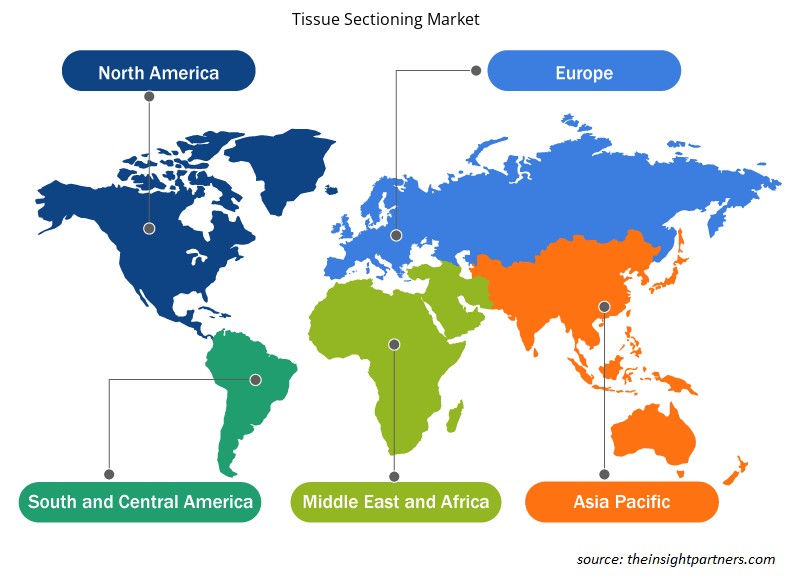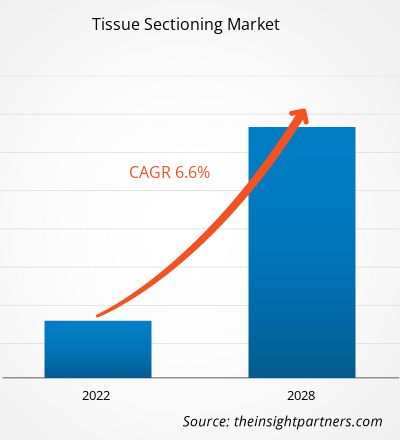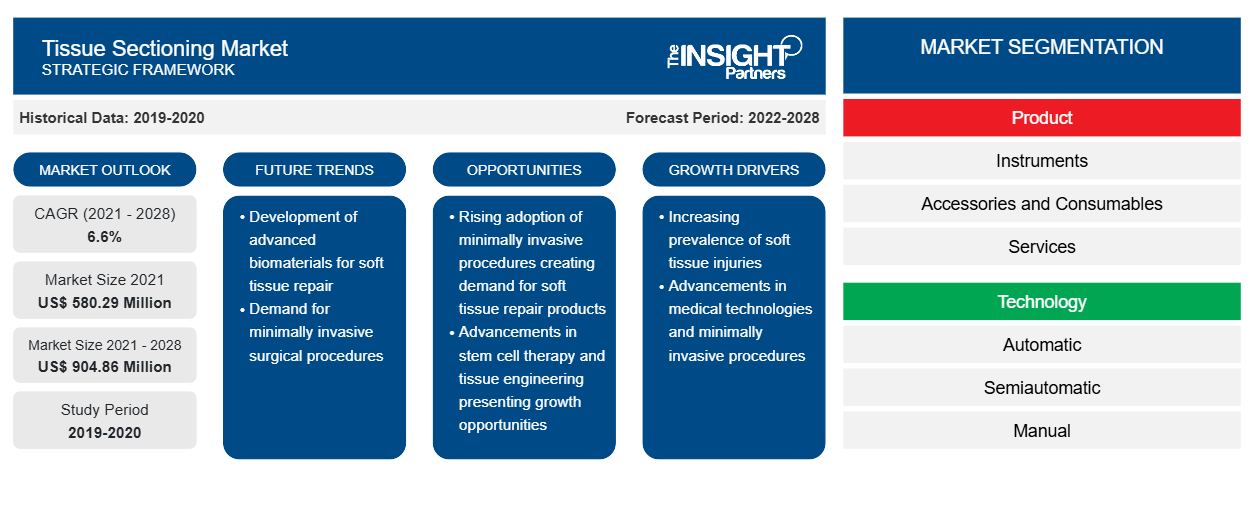Se proyecta que el mercado de seccionamiento de tejidos alcance los US$ 904,86 millones para 2028 desde los US$ 580,29 millones en 2021; se espera que crezca a una CAGR del 6,6% entre 2021 y 2028.
El seccionamiento de tejido es un procedimiento que implica cortar tejidos en secciones delgadas para poder colocarlas en un portaobjetos y luego montarlas bajo un microscopio para su estudio. Se utiliza para examinar el tejido y detectar cualquier anomalía o enfermedad. Se emplea en laboratorios de histología, laboratorios científicos y otros entornos. El procesamiento del tejido se lleva a cabo después de que el tejido haya sido examinado entre la inclusión y la fijación del tejido.
El informe ofrece información y un análisis profundo del mercado de seccionamiento de tejidos , haciendo hincapié en varios parámetros como las tendencias del mercado, los avances tecnológicos, la dinámica del mercado y el análisis del panorama competitivo de los principales actores del mercado en todo el mundo. También incluye el impacto de la pandemia de COVID-19 en el mercado en todas las regiones. La pandemia ha alterado las condiciones socioeconómicas de varios países del mundo. Actualmente, Estados Unidos es el país más afectado del mundo debido al brote de COVID-19 con el mayor número de casos confirmados y muertes, según las estadísticas recientes de la OMS. El elevado número de casos positivos de COVID-19 ha afectado negativamente a las economías mundiales. Ha habido una disminución de las actividades comerciales generales y el crecimiento de varias industrias que operan en todo el mundo.
Personalice este informe según sus necesidades
Obtendrá personalización en cualquier informe, sin cargo, incluidas partes de este informe o análisis a nivel de país, paquete de datos de Excel, así como también grandes ofertas y descuentos para empresas emergentes y universidades.
-
Obtenga las principales tendencias clave del mercado de este informe.Esta muestra GRATUITA incluirá análisis de datos, desde tendencias del mercado hasta estimaciones y pronósticos.
Ha habido varios factores, incluido el aumento de la incidencia de pacientes positivos a COVID-19, el crecimiento de la investigación, el aumento de la producción de vacunas, el estudio de los resultados de las vacunas administradas y muchos otros factores. Por ejemplo, el Colegio de Patólogos de Estados Unidos realizó una investigación para informar sobre las características demográficas y radiográficas de los pulmones de los pacientes infectados y fallecidos con COVID-19 fatal. Todas las autopsias se realizaron en el Colegio de Patólogos de Estados Unidos. El estudio reveló que los pacientes infectados con COVID-19 no solo tienen daño alveolar difuso, sino que también suelen tener bronconeumonía aguda y neumonía por aspiración. Los casos llevaron principalmente a la demanda de pruebas de diagnóstico en países como Estados Unidos, Canadá y México. Por lo tanto, el mercado de seccionamiento de tejidos en América del Norte se ve afectado positivamente por COVID-19.radiographic features in the lungs of patients infected and deceased with fatal COVID-19. All autopsies were performed at the College of American Pathologists. The study revealed that patients infected with COVID-19 not only have diffuse alveolar damage but also commonly have acute bronchopneumonia and aspiration pneumonia. The cases majorly led to the demand for diagnostic tests in the countries like the US, Canada, and Mexico. Thus, the tissue sectioning market in North America is positively impacted by COVID-19.
Según la región, el mercado de seccionamiento de tejidos está segmentado en América del Norte, Europa, Asia Pacífico, Medio Oriente y África, y América del Sur y Central.
Perspectivas del mercado
La creciente adopción de la medicina personalizada impulsará el mercado del corte de tejidos
La medicina personalizada o de precisión se ha convertido en el sello distintivo del tratamiento de una serie de enfermedades graves y se ha expandido a otros campos con su aplicación. Es un enfoque en constante evolución para personalizar las terapias en función de la acumulación genética de los pacientes. Estos avances tecnológicos han dado lugar a enfoques de seccionamiento de tejidos que consiguen mejores resultados con los recursos disponibles en menos tiempo. Para la prevención y el tratamiento eficiente de una enfermedad, los medicamentos personalizados son herramientas obligatorias, especialmente en casos de oncología y nefrología. El rápido aumento de los casos de cáncer está contribuyendo indirectamente al crecimiento del mercado de seccionamiento de tejidos.nephrology cases. The rapidly increasing cancer cases are indirectly contributing to the growth of the tissue sectioning market.
Por ejemplo, según la OMS, el cáncer es la principal causa de muerte en todo el mundo, y en 2020 fue responsable de casi 10 millones de muertes. El cáncer de pulmón, el cáncer de hígado, el cáncer de sangre y el cáncer de mama son los tipos de cáncer más comunes. Actualmente, entre el 30% y el 50% de los cánceres se pueden prevenir mediante un diagnóstico temprano y un tratamiento y atención adecuados de los pacientes. Muchos cánceres tienen muchas posibilidades de curarse si se diagnostican a tiempo y se tratan adecuadamente, afirmó la OMS. El uso cada vez mayor de la medicina personalizada ha provocado un aumento de la demanda de uso de tejido humano para fomentar pruebas innovadoras.
Perspectivas basadas en productos
Según el producto, el mercado de corte de tejidos se clasifica en instrumentos, accesorios y consumibles, y servicios. El segmento de instrumentos representó la mayor participación del mercado. El segmento de instrumentos se subdivide en micrótomos rotatorios, micrótomos deslizantes, ultramicrótomos, criostatos y otros. subsegmented into rotary microtome, sliding microtome, ultramicrotome, cryostat, and others.
Perspectivas basadas en la tecnología
Según la tecnología, el mercado de corte de tejidos se segmenta en automático, semiautomático y manual. El segmento de tecnología automática tendría la mayor participación del mercado en 2021, y se estima que el mismo segmento registrará la CAGR más alta del mercado, del 7,0 %, durante el período de pronóstico.CAGR of 7.0% in the market during the forecast period.
Perspectivas basadas en aplicaciones
Según la aplicación, el mercado de corte de tejidos se segmenta en diagnóstico e investigación. En 2021, el segmento de diagnóstico tendrá la mayor participación del mercado. Además, también se espera que el segmento de investigación experimente un crecimiento a la tasa compuesta anual más rápida del 7,2 % entre 2021 y 2028.CAGR of 7.2% from 2021 to 2028.
Información basada en el usuario final
Según el usuario final, el mercado de corte de tejidos se segmenta en hospitales, instituciones de investigación y otros. El segmento de instituciones de investigación tendría la mayor participación del mercado en 2021, y se prevé que el mismo segmento registre la CAGR más alta del 10,9 % del mercado durante el período de pronóstico.CAGR of 10.9% of the market during the forecast period.
Los actores del mercado de seccionamiento de tejidos adoptan estrategias orgánicas como el lanzamiento y la expansión de productos para expandir su presencia y cartera de productos en todo el mundo y satisfacer la creciente demanda.
Perspectivas regionales del mercado de seccionamiento de tejidos
Los analistas de Insight Partners explicaron en detalle las tendencias y los factores regionales que influyen en el mercado de seccionamiento de tejidos durante el período de pronóstico. Esta sección también analiza los segmentos y la geografía del mercado de seccionamiento de tejidos en América del Norte, Europa, Asia Pacífico, Oriente Medio y África, y América del Sur y Central.

- Obtenga datos regionales específicos para el mercado de seccionamiento de tejidos
Alcance del informe de mercado de seccionamiento de tejidos
| Atributo del informe | Detalles |
|---|---|
| Tamaño del mercado en 2021 | US$ 580,29 millones |
| Tamaño del mercado en 2028 | US$ 904,86 millones |
| CAGR global (2021-2028) | 6,6% |
| Datos históricos | 2019-2020 |
| Período de pronóstico | 2022-2028 |
| Segmentos cubiertos |
Por producto
|
| Regiones y países cubiertos |
América del norte
|
| Líderes del mercado y perfiles de empresas clave |
|
Densidad de actores del mercado de seccionamiento de tejidos: comprensión de su impacto en la dinámica empresarial
El mercado de corte de tejidos está creciendo rápidamente, impulsado por la creciente demanda de los usuarios finales debido a factores como la evolución de las preferencias de los consumidores, los avances tecnológicos y una mayor conciencia de los beneficios del producto. A medida que aumenta la demanda, las empresas amplían sus ofertas, innovan para satisfacer las necesidades de los consumidores y aprovechan las tendencias emergentes, lo que impulsa aún más el crecimiento del mercado.
La densidad de actores del mercado se refiere a la distribución de las empresas o firmas que operan dentro de un mercado o industria en particular. Indica cuántos competidores (actores del mercado) están presentes en un espacio de mercado determinado en relación con su tamaño o valor total de mercado.
Las principales empresas que operan en el mercado de seccionamiento de tejidos son:
- Termo Fisher Scientific
- Leica Biosystems Nussloch GmbH
- LLS ROWIAK LaserLabSolutions GmbH
- Sakura Finetek Europe BV
- EspA diapática
Descargo de responsabilidad : Las empresas enumeradas anteriormente no están clasificadas en ningún orden particular.

- Obtenga una descripción general de los principales actores clave del mercado de seccionamiento de tejidos
Por producto
-
Instrumentos
- Micrótomo rotatorio
- Ultramicrotomo
- Criostato
- Micrótomo deslizante
- Otros
- Accesorios y consumibles
- Servicios
Por tecnología
- Automático
- Semiautomático
- Manual
Por aplicación
- Diagnóstico
- Investigación
Por el usuario final
- Hospitales
- Clínicas
- Laboratorios de diagnóstico
- Laboratorios de Caminos Digitales
- Otros
Por geografía
-
América del norte
- A NOSOTROS
- Canadá
- México
-
Europa
- Francia
- Alemania
- Italia
- Reino Unido
- España
-
Asia Pacífico (APAC)
- Porcelana
- India
- Corea del Sur
- Japón
- Australia
-
Oriente Medio y África (MEA)
- Sudáfrica
- Arabia Saudita
- Israel
-
América del Sur y Central (SCAM)
- Brasil
Perfiles de empresas
- Termo Fisher Scientific
- Leica Biosystems Nussloch GmbH
- LLS ROWIAK LaserLabSolutions GmbH
- Sakura Finetek Europe BV
- EspA diapática
- Laboratorios Histo-line
- Medite Medical GmbH
- SLEE Medical GmbH
- Abcam plc
- Amas Scientific Pty Ltd
- Análisis histórico (2 años), año base, pronóstico (7 años) con CAGR
- Análisis PEST y FODA
- Tamaño del mercado, valor/volumen: global, regional y nacional
- Industria y panorama competitivo
- Conjunto de datos de Excel
Informes recientes
Testimonios
Razón para comprar
- Toma de decisiones informada
- Comprensión de la dinámica del mercado
- Análisis competitivo
- Información sobre clientes
- Pronósticos del mercado
- Mitigación de riesgos
- Planificación estratégica
- Justificación de la inversión
- Identificación de mercados emergentes
- Mejora de las estrategias de marketing
- Impulso de la eficiencia operativa
- Alineación con las tendencias regulatorias























 Obtenga una muestra gratuita para - Mercado de seccionamiento de tejidos
Obtenga una muestra gratuita para - Mercado de seccionamiento de tejidos